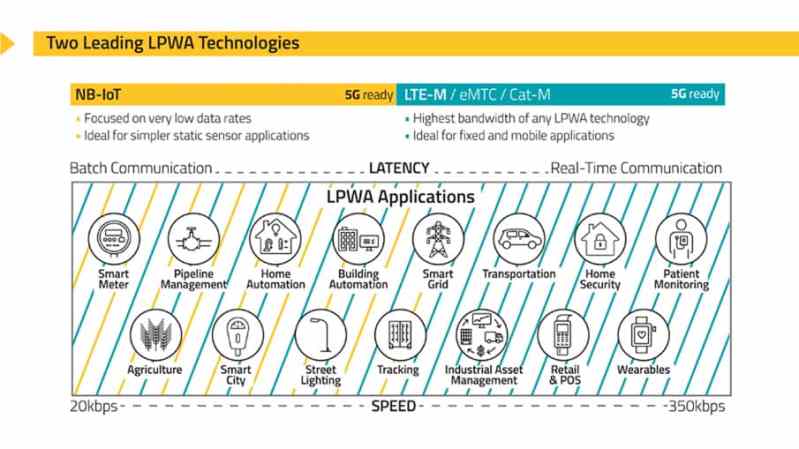In my last posts in this series, I wrote about how Low Power Wide Area (LPWA) technologies are addressing the critical four C’s for the IoT , and the benefits of standard versus proprietary technologies .
Standardized LPWA technologies from 3GPP (LTE-M, NB-IoT and EC-GSM-IOT) come from the same proven and trusted mobile cellular technologies used in smartphones, with specific advancements designed for the IoT (the four C’s). They have greatly improved coverage that allows deep indoor usage (even in basements) and are extremely power efficient so that IoT devices can run and communicate on batteries for up to 15 years.
The 3GPP has specified three flavors of LPWA technologies to run on licensed bands:
- LTE-M or eMTC, an evolution of LTE technology with the first defined subcategory being “Category-M1” or Cat-M1
- NB-IoT, a narrower adaptation of LTE technology designed to fit into 2G channels, with the first defined subcategory being “Category-NB1” or Cat-NB1
- EC-GSM-IoT (usually shortened to EC-GSM), a 2G evolution of the GSM technology very well suited in countries with a strong existing 2G coverage

Why did the 3GPP define three different technologies? The simple answer is that every geographic region has a different mix of 2G and 4G LTE network infrastructure deployed and, since all three of these LPWA technologies leverage the existing network infrastructure (i.e. can be deployed by software upgrade to the base stations), different LPWA technologies are needed.
- LTE-M is the most flexible LPWA technology, supporting both simple static sensor applications, as well as applications requiring voice, mobility, and slighting higher throughput.
- NB-IoT is ideal for simpler sensor applications requiring very low throughput, and although the standard supports re-farming 2G spectrum, all commercial deployments today have been deployed within an LTE system using in-band dedicated spectrum.
- EC-GSM-IoT is a 2G technology and likely to be strong in countries that are committed to keeping their 2G networks up for many years and/or where 4G coverage is insufficient, including Europe, China, India, Malaysia, Russia, Africa, Middle East, South and Central America, and Mexico. It's important to note that although technology trials have begun, the commercial timing of EC-GSM is hard to predict and will require a combined ecosystem adoption of the technology.
By the end of 2018, we expect that both LTE-M and NB-IoT networks will both be available in many regions, giving OEMs options when selecting which technology to choose. And to make it even easier, Sierra Wireless supports multiple LPWA technologies on the same module for companies wanting to deploy their solutions on different LPWA cellular networks worldwide using the same hardware.
But there are some differences between LTE-M and NB-IoT, such as data rates and real-time communications support, such as voice. So think through both near- and long-term application requirements before selecting an LPWA technology. For example, it was commonly thought that IoT would never need voice, but it’s now a growing requirement for many IoT applications, including vehicles, wearables, elevators and healthcare applications, to name a few. The next invented killer IoT application may very well need real-time communications.
| Attribute |
CAT-M1 (LTE-M) |
CAT-NB1 (NB-IoT) |
EC-GSM |
| Voice Capability |
Yes |
No |
Yes |
| Mobility |
Full |
Partial |
Full |
| Data Rate |
375 kbps |
20-65 kbps |
70 kbps |
| Latency |
Fast (~same as LTE) |
Medium |
Slow |
The good news is that most chipsets and module vendors will be able to support more than one 3GPP LPWA technology, so the choice will really come down to the feature requirements of your application.

Choosing the right 3GPP LPWA is not like a VHS vs Beta or Wi-MAX vs LTE, we expect both LTE-M and NB-IoT to be wildly successful, as well as EC-GSM-IoT if the ecosystem decides to support it!
Looking for more information about LPWA? Start with Sierra to speak with one of our experts who can help you deploy the right LPWA technology for your application, or read the blog, LTE-M and NB-IoT: What to Know Before You Start Development. Download the whitepapers, LPWA: Separating Fact From Fiction, Coverage Analysis of LTE-M Category M1 and our What is LPWA? infographic.
Editor’s Note: This post was originally published in August 2016 and has been updated for accuracy and comprehensiveness.



